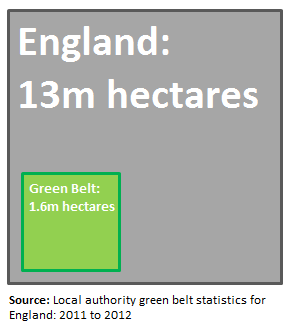Is England's Green Belt set to be reduced by local councils?
*Title originally used the term 'eroded' which we decided was too partial. It has been changed thanks to Twitter feedback.
Is Britain's green and pleasant land about to become a little less green? That's what readers of this morning's Times were told, as the paper reported that the area we know as the 'green belt' might not be as big in a decade or so's time:
"Surge in homes planned for green-belt sites"
The figures behind the story come from the Campaign to Protect Rural England (CPRE), which campaigns (among other things) to protect the Green Belt from encroachment from new homes.
It has previously said that there is enough brownfield land (previously developed land that isn't currently in full use) to build 1.5 million new homes. This is true in theory, although in practice much of this land needs a lot of work done before it's suitable for housebuilding.
What's going on
The 150,000 'proposed' homes come from local councils' planning, strategy and consultation documents on new developments, identified by CPRE as including land designated as Green Belt.

It's worth being clear what exactly these figures refer to: CPRE's research gathers information about housebuilding proposals at various stages of the planning process at councils which have Green Belt land. In some cases the proposals are at consultation stage with local residents, in other cases the proposals are set out as part of councils' 'core strategy' for the years ahead.
In addition, the total 150,000 figure refers to the expected number of homes built over the next twenty years (as CPRE put it, the lifespan of most local plans).
There's good reason to think however that these figures will overestimate the number of homes that will actually be built on these sites. As we discovered last week, 400,000 homes in England have been given planning permission but have yet to be built (110,000 properties actually get built each year) as the homes sit in 'landbanks' held by developers.
For this reason, even if all the homes earmarked across these councils get to the final stages of the planning process, they will still need the funding and will to actually be built, so we shouldn't necessarily assume that the plans will correlate with actual building (especially in the cases where "up to" a certain number of houses are planned).
Another point worth bearing in mind is that, as CPRE point out, in September last year the Chancellor called for more 'land swaps', which involve developing existing Green Belt sites and categorising new land as Green Belt to balance this out (although CPRE dispute its merits, saying it discourages permanence of green land and hides the difficultly of so designating the land).
Why it's happening
After pledging "We will maintain the Green Belt" in the Coalition Agreement, the current government set out its plans in the National Planning Policy Framework (NPPF) in March 2012, stating:
"New Green Belts should only be established in exceptional circumstances, for example when planning for larger scale development such as new settlements or major urban extensions ...
"A local planning authority should regard the construction of new buildings as inappropriate in Green Belt [with exceptions]."
These exceptions are important: they include using Green Belt land for agricultural or sport uses, but also for "limited" affordable housing for local community needs or extending existing brownfield sites. The NPPF also gives local councils (who make the planning decisions) general flexibility as well:
"We encourage councils to use the flexibilities set out in the National Planning Policy Framework to tailor the extent of Green Belt land in their areas to reflect local circumstances."
As CPRE's evidence indicates, this is leading to some councils proposing development on existing Green Belt land.